Eddie Bauer BC Freshline Jacket
Test Location: Crested Butte, Colorado
Days Tested: ~18
Reviewer: 5’8”, 155 Ibs
Size Tested: Medium
Blister’s Measured Weight (size Medium): 701 grams
Materials:
- Torso & Underarms: 3-layer eVent DValpine
- Rest of Jacket: 3-layer eVent DVexpedition
Stated Features:
- StormRepel® Super DWR: Our longest lasting moisture-shedding finish
- Adjustable, helmet-compatible hood with high front collar: Extra face protection when fully zipped
- Quick-venting pit zips: Regulate temperature to avoid overheating
- Cohesive embedded cordlocks at hood and hem: Dial in fit
- Stretch over-glove thumb loops on cuffs: Secure, streamlined fit
- Average length, Med: Reg 31″
- Classic; A universal fit. Not too slim, not too relaxed on body. Designed to fit over midweight layers.
Pockets:
- 2 exterior zippered chest pockets
- 2 exterior zippered hand pockets
- 1 exterior zippered bicep pocket
- 1 interior drop-in pocket
- 1 interior zippered chest pocket
MSRP: $549 (on sale for $275 as of publishing date)
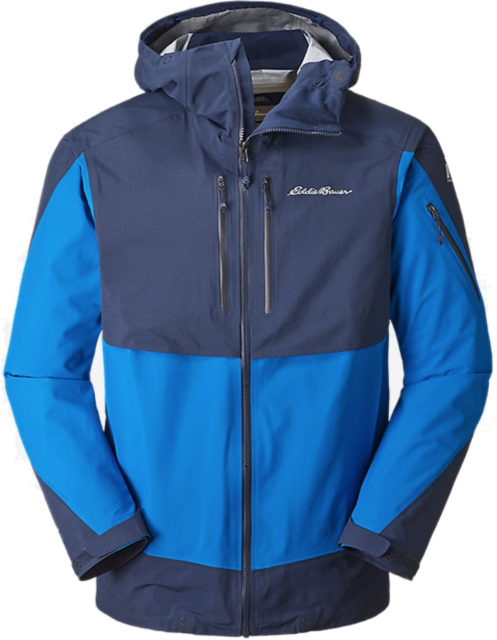
Intro
This past season Eddie Bauer announced an overhaul of their backcountry outerwear series, the BC Freshline. Designed with the help of Eddie Bauer athletes KC Deane, Drew Tabke, Lexi DuPont and Lynsey Dyer, the BC Freshline is interesting not only because it’s pretty different than what the brand has previously put out, but also because it uses eVent fabrics, which are somewhat rare these days.
I was excited about the BC Freshline Jacket as soon as I heard about it, especially because the air-permeable, yet waterproof eVent fabric seemed like it could be a great option for high-output days on the skin track, and I hadn’t been in eVent’s most recent fabric options.
So I’ve been using the BC Freshline Jacket in the backcountry around Crested Butte and also for some days in the resort. Sam Shaheen has also been using the BC Freshline Bibs, so we’re planning on having him weigh in on those at a later time. But for now, let’s discuss the jacket, since this is one of my favorite ski shells I’ve used in a while.
Fit
Eddie Bauer says the BC Freshline Jacket features their “Classic Fit,” which they say is “not too slim, not too relaxed on body. Designed to fit over midweight layers.”
Overall, I’d say that’s pretty accurate, though with some caveats.
In terms of overall volume, the BC Freshline Jacket is pretty average compared to a variety of touring- and resort-oriented ski shells. In this regard, it feels fairly similar to the Houdini Rollercoaster Jacket and Patagonia Untracked Jacket. The BC Freshline Jacket is not as big and roomy as the Black Diamond Mission Jacket or Norrona Tamok Gore-Tex Pro Jacket, but it’s roomier than touring shells like the Norrona Lyngen Hybrid.
I’ve had no problems fitting the BC Freshline Jacket over midweight puffies like the Patagonia Micro Puff Hoody and Patagonia DAS Light Hoody, and never noticed any restriction while skiing in those combos. And those hoodies can also fit over the BC Freshline Jacket without feeling super tight.
The BC Freshline Jacket is not super long, with the size Medium hitting a bit above my hips (I’m 5’8”, 155 lbs). The sleeves are also a bit short; while I had no issues with them riding up too much on my arms, Sam (who’s 5’10”) was wishing for slightly longer sleeves while reaching up (e.g., while booting up a couloir).
The main fit complaint that Sam and I had with the BC Freshline Jacket was regarding the shoulder area. Trying to reach above our heads or extending our arms fully out in front of our bodies left the jacket feeling quite tight around the shoulders. Personally, I never noticed this while skinning or skiing, but if you want a shell that you’ll use for a lot of vertical climbing, this is definitely something to consider. The other issue this caused was that my back protector also made the jacket pretty tight across the shoulders. Again, not a big enough issue for me to choose another jacket, but think that people with very broad shoulders might be better off in a different shell.
Pockets
For a jacket that was designed at least partially with backcountry skiing in mind, the BC Freshline Jacket is very fully featured.
It has seven pockets — five on the outside and two on the inside. There are two exterior chest pockets, two exterior hand pockets, and a small pocket on the bicep. The chest pockets are easy to access while wearing a pack, the bicep pocket is nice for lip balm or a card / pass, and the hand pockets are nice to have when skiing in the resort or just walking around.
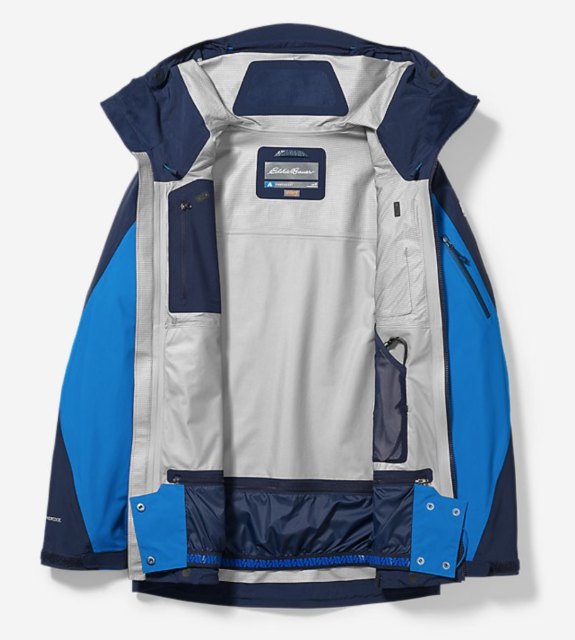
I have been able to cram my smallest skins (cut for the 178 cm long, 98mm-wide Line Vision 98) into the BC Freshline Jacket’s hand pockets, but it was a very tight fit. Given that, I’ve usually just stashed my skins loosely inside the jacket and relied on my backpack straps to keep them from falling out, or just put them in my pack. Personally, I’d prefer bigger chest pockets that fit skins, but if you don’t typically put your skins in your jacket pockets, it obviously won’t be an issue.
The inside of the BC Freshline Jacket features a small, zippered chest pocket that’s great for a phone or snacks, and then a mesh drop-in pocket that I usually use for gloves or goggles (it’s got a fairly small opening so it’s tough to fit skins in it).
Other Features
The BC Freshline Jacket features embedded Cohesive cordlocks in the hem and hood, which do a great job of making those areas easy to adjust with gloves on, and don’t leave long cords dangling to get caught on stuff or hit you in the face. The hood is helmet compatible and I’d say it’s about average in terms of range of motion and field of view.
The jacket features a removable powder skirt that’s pretty par for the course, velcro / hook & loop cuffs, and patches of microfleece around the chin and neck which I really like as they’re way more comfortable on skin than the backer of the eVent fabric. The cuffs also feature small loops inside the sleeves that you can use to put your thumbs through, though I’ve almost never used this feature since the sleeve length is fine for me.
Under the arms, the BC Freshline Jacket features fairly small 36 cm / 14” pit zips which have been pretty easy to use, but like most pit zips, they require two hands for me to get them to move. I do like that Eddie Bauer went with two-way zippers on the BC Freshline Jacket’s pit zips as it makes it easier to get them open / closed while wearing a pack.
Apart from the lack of viable in-jacket skin storage, the BC Freshline Jacket’s velcro cuffs are my only other complaint. Compared to the cuffs on most of the other shells I’ve used, the velcro on the BC Freshline Jacket’s cuffs does not do as good of a job of staying closed / latched. I usually keep my jacket cuffs wide open anyway, but I’d like to see some higher-quality velcro used on the BC Freshline Jacket.
Weight
The BC Freshline Jacket is not super light, with our size Medium coming in at 701 grams. It’s much heavier than most dedicated touring shells, though it uses much burlier fabrics and has many more features. The BC Freshline is still lighter than some inbounds-oriented shells, but if low weight is a priority, you’ve got better options. Packed down, the BC Freshline Jacket is about the size of an NFL football or a bit smaller than a regulation soccer ball.
For reference, here’s a list of some of the other shells we’ve reviewed, and their respective measured weights. Note that not all of the pieces are the same size, so try to keep that in mind when making comparisons.
364 g Black Diamond Helio Active Shell, size Medium
366 g Patagonia Ascensionist Jacket, size Medium
435 g Arc’teryx Rush LT Jacket, size Medium
518 g Flylow Cooper Jacket, size Medium
544 g Outdoor Research Hemispheres Jacket, size Medium
563 g Rab Sharp Edge Jacket, size Medium
571 g TREW Capow Jacket, size Medium
574 g Amundsen Peak Anorak, size Medium
590 g Flylow Higgins Coat 2.1, size Large
593 g Patagonia PowSlayer Jacket, size Large
598 g The North Face Freethinker Jacket, size Medium
601 g Spyder Sanction GTX Pro Shell Jacket, size Medium
605 g Patagonia Descensionist Jacket, size Medium
610 g Strafe Cham Jacket, size Large
615 g Patagonia SnowDrifter Jacket, size Medium
626 g Arc’teryx Sabre LT Jacket, size Medium
635 g Mammut Alvier Armor Hardshell Jacket, size Medium
665 g Norrona Tamok Gore-Tex Pro Jacket, size Medium
701 g Eddie Bauer BC Freshline Jacket, size Medium
726 g Holden M-51 Fishtail 3 Layer Jacket, size Medium
825 g The North Face Ceptor Jacket, size Medium
841 g Strafe Pyramid Jacket, size Large
848 g Open Wear Open One 3L Shell Jacket, size Medium
1047 g FW Manifest 3L Jacket, size Large
Materials
The BC Freshline Jacket uses two different 3-layer eVent fabrics: DVexpedition (light orange) and DValpine (dark orange). The “expedition” fabric uses a thick backer and is reportedly rated to 30K for waterproofing and 10K for breathability, while the “alpine” fabric features a lighter, more supple backer and has a stated 20K / 20K waterproof / breathability rating. As with all eVent fabrics, both versions used on the BC Freshline Jacket are air-permeable, and as a result I don’t think those fairly low breathability specs are very reflective of real use (more on that later).
The DVexpedition fabric on the BC Freshline Jacket is very burly and pretty crinkly. It’s thicker and a bit stiffer than the Gore-Tex Pro fabric with a 70Dx160D face fabric used on the Norrona Tamok Gore-Tex Pro Jacket.
The DValpine fabric is lighter, thinner, and a bit more supple. It feels fairly similar to the fabric used on the Arc’teryx Sabre LT Jacket. All in all, the BC Freshline Jacket is significantly less supple and comfy on skin vs. most Gore-Tex C-Knit fabrics, the Patagonia Snowdrifter & Stormstride fabrics, and the fabric on the Houdini Rollercoaster & Shelter Jackets. But I’d say the BC Freshline Jacket feels fairly similar to a Gore-Tex Pro fabric in terms of comfort — pretty average for a waterproof hardshell.
Weather Resistance
I’ve used the BC Freshline Jacket on several very deep days, some of which had temps around 30°F / -1°C, as well as a bit of rain. I have never had any water get through the fabric, and the DWR has done a pretty good job of initially beading up water.
For how breathable the BC Freshline Jacket’s eVent fabrics are (see below), I’m impressed by its waterproofing. I think this combination is what will make it so appealing to backcountry skiers, especially those who live in wetter climates and who therefore may not want to go with some of the super breathable fabrics out there like Polartec NeoShell, which can wet out in really wet weather.
Breathability
This is what makes the BC Freshline Jacket and eVent stand out.
It’s been a while since I’ve been in an eVent jacket and I was honestly doubtful that it could match the breathability of some of the most breathable shell fabrics like NeoShell, Polartec PowerShield Pro, Strafe’s Recon 3L, and the old Patagonia Descensionist fabric. (For more info on the variety of waterproof / breathable fabrics and how they differ, check out our Outerwear 101 & 201 articles.)
After doing some back-to-back days skinning in a few of those fabric options, I was surprised by how small of a difference I noticed between them in terms of breathability. All of those other fabrics left me a bit drier and cooler than the BC Freshline Jacket, but the difference was pretty dang subtle. I rarely skin while wearing my shell, but the BC Freshline Jacket is one of the few shells I’ve used that I’m comfortable wearing for extended uphills. I’d say that it’s actual breathability feels much, much better than other fabrics I’ve used with “10K” or “20K” breathability ratings, which is why we tend to not pay much attention to breathability ratings in the first place.
I’ve done several days in the BC Freshline Jacket where I skin with it and a light wool baselayer for 45 minutes to ~2 hours in temps ranging from 20°F to 35°F (-6.7–1.7°C). In those scenarios, I definitely still worked up a sweat, but I was comfortable enough that I didn’t mind wearing the jacket. If I know it’s not going to be super windy or snowing, I’ll still skin in my baselayer (that’s always what I prefer). But for skinning on pow days or windy ridgelines, the BC Freshline Jacket is one of the better shells I’ve used.
Warmth
This is a shell with no insulation, so it’s not very warm. It blocks wind and water and traps a tiny amount of body heat, but you’ll definitely want to layer under it. The BC Freshline Jacket is not out of the ordinary compared to other shells in terms of warmth; I haven’t felt the need to make any changes to the rest of my layering system while switching between it and other shells.
Durability
So far, so good — the BC Freshline Jacket basically looks like new after using it for about 18 days, apart from some small stains.
Overall, I think the BC Freshline Jacket will be pretty durable, mostly due to the burly eVent DVexpedition fabric used in high-wear areas like the hood, shoulders, hem, and the back of the arms. Especially compared to ultralight touring shells like the Black Diamond Helio Active Shell & Patagonia Ascensionist, I’d expect the BC Freshline Jacket to hold up much better to repeated abrasion and impacts.
In the past, eVent fabrics were known to be finicky in terms of washing / drying, which was a big reason why eVent updated their fabrics and came out with the revised “DV” versions that this jacket uses. Eddie Bauer recommends pretty standard care for the BC Freshline Jacket (machine wash cold & delicate, tumble dry low) and I didn’t notice any issues after one wash / dry cycle, but I’ll be sure to update this article if I run into any durability issues down the line.
Who’s It For?
Skiers & snowboarders who want a fully waterproof, fully featured jacket but who also prioritize breathability.
For a place like Colorado or a similarly dry climate, backcountry skiers could get away with a more breathable and less waterproof softshell. And the BC Freshline Jacket is not the lightest or most packable shell out there, so gram-counters have better options. And then those who are looking for a dedicated inbounds shell could go with something cheaper and / or burlier without losing out on much performance in that low-output case.
But for backcountry skiers, people who tend to hike a lot in the resort, and those who do both, the BC Freshline Jacket is a very solid option. It offers very good breathability, given that it’s proven fully waterproof in my experience. I think this makes it a great choice for backcountry skiers in areas like the US Pacific Northwest, British Columbia, or Japan, where you’re likely to end up skinning and / or skiing in wet weather and where super breathable jackets can get overwhelmed by the moisture.
Bottom Line
The Eddie Bauer BC Freshline Jacket is an impressively breathable, fully waterproof, and generously featured shell. It’s not the lightest or most comfy shell on the market, but its excellent blend of weather protection and breathability makes it worth a very good look for skiers and snowboarders who want storm protection that doesn’t make them sweat buckets as soon as they head uphill.

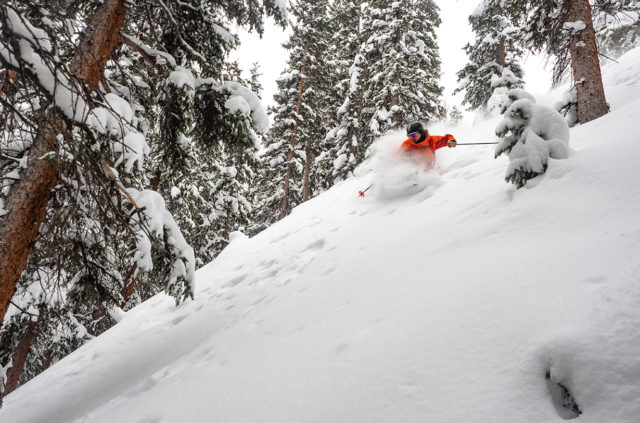
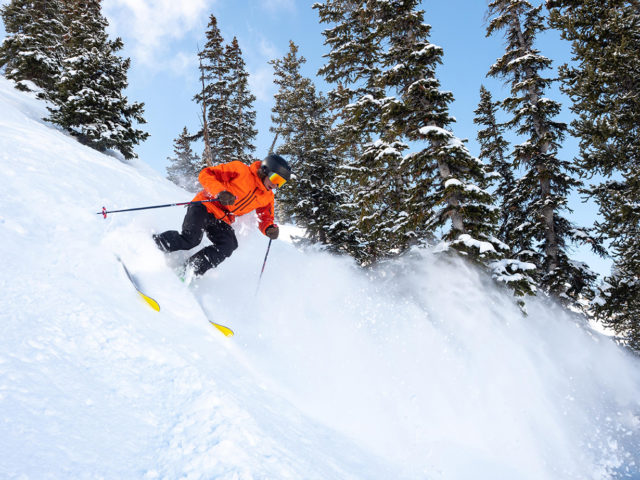
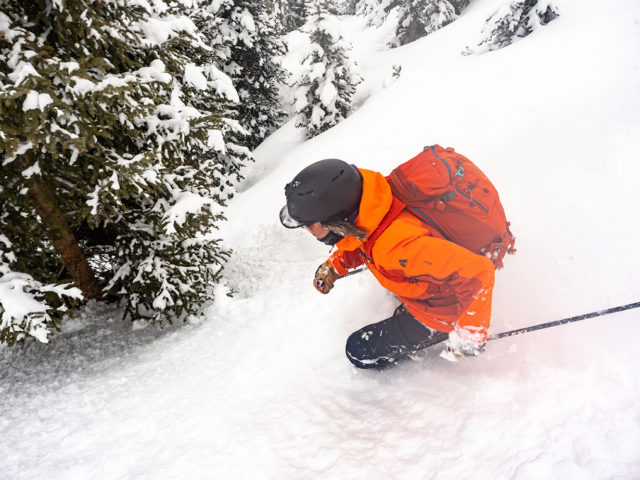
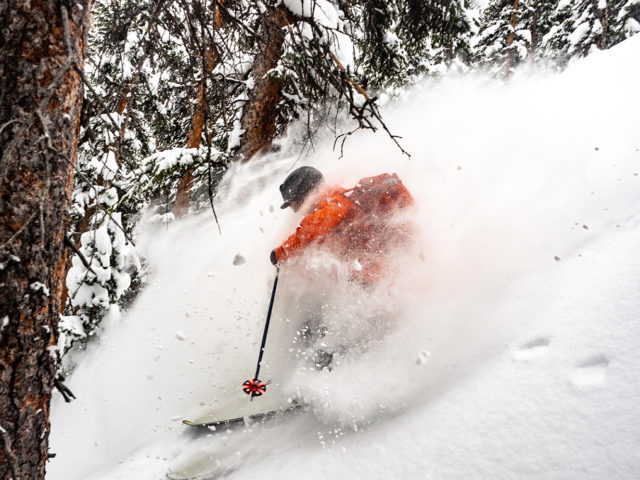
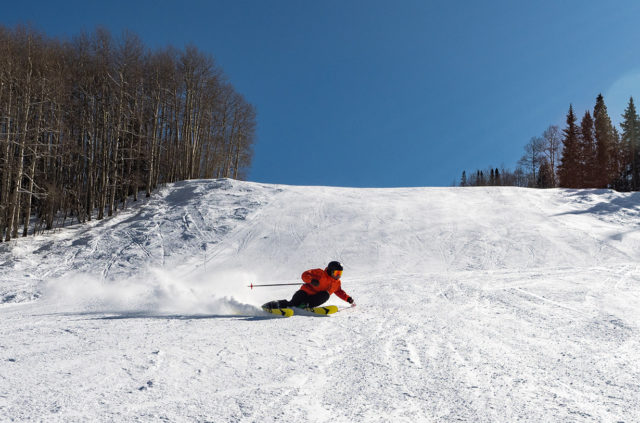
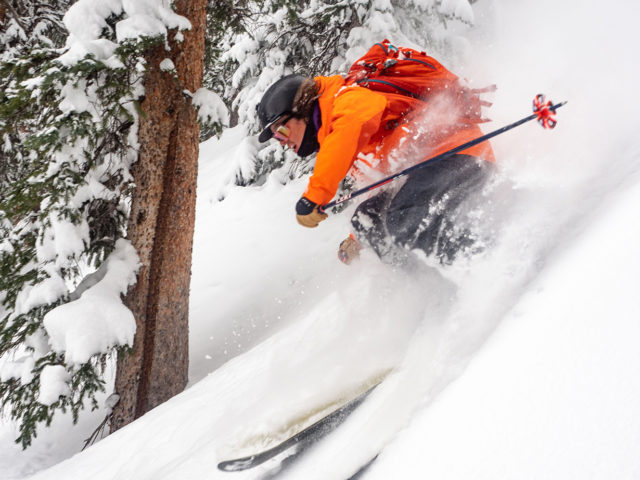
Does Blister reviewing an Eddie Bauer jacket count as a sign of the apocalypse?
Or has the brand become ironically retro-hip, like PBR?
Interesting that you mention a back protector. It would be great to see Blister do something on what you consider to be standard protective equipment for backcountry skiing. When I first started skiing nobody wore a helmet unless you were ski racer. Now almost everyone wears one. What other equipement isn’t yet in that category, but people should be wearing, I wonder?
Yeah to be honest, I personally don’t wear my back protector very often in the backcountry unless I plan on hitting some drops or building jumps, mostly cause the one I have is pretty hot. I do wear it every day skiing in the resort though, and now see it as an essential part of my kit for the resort. I’m planning on doing a back protector roundup next year and also looking into some other protection options. FWIW, the Freeride World Tour & Qualifier series now requires every participant to wear one, in addition to a helmet.
A roundup would be great, thanks Luke. I’ve never worn a back protector, but now that I think about it, it seems like a total no-brainer to wear one in the resort at the very least.
+1 to the suggestion of a roundup or 101 article.
Was searching high and low for a jacket that had true “skin-accepting” pockets. The Marmot BL Pro has fit the bill. It takes all my skins– from Brahmas to Praxis Protest (187 length, 128mm width). The large hand pockets are also open to the bottom of the jacket, which is relatively long. That means the skins lie vertically quite flat and low-ish under the pack waist strap. Other jackets these days tend to either 1) forego ski pockets altogether because it is so “unfashionable” to have pockets under your pack waist belt, or 2) have higher hand (skin) pockets that give you a set of chest protrusions when you want to warm your skins. Not the best for a photo op! Most of the time though, if you have some temporary visibility at the top of a long climb, you want to transition fast in order to see well-enough to shred. With Tectons/ Vipecs for example, you don’t have to take your skis off for that (or worry whether you got the pins in correctly on a steep pow slope). And with a good jacket you don’t have to fiddle with putting skins somewhere into your (too full) ski pack. So yeah. Marmot BL Pro just works if you tour a lot for pow and want quick transitions, and do want those skins to warm up (and/or not soak the puffy you really want to have dry for lunch/ storm time). Just sayin’
I spent the winter in the Bibs, I love them, I used them in sub 0F weather to 40 and rainy in the resort and never had an issue. I also did some backcountry days and had no issues with the breathability. They are well thought out and have enough pockets for everything I need to do. Can’t wait to hear your review.